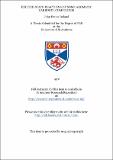Files in this item
Excited state reactions of some aromatic carbonyl compounds
Item metadata
| dc.contributor.advisor | Wyatt, P. A. H. (Peter Arthur Harris) | |
| dc.contributor.author | Ireland, John Frame | |
| dc.coverage.spatial | viii, 162 p. | en_US |
| dc.date.accessioned | 2018-07-10T08:08:44Z | |
| dc.date.available | 2018-07-10T08:08:44Z | |
| dc.date.issued | 1972 | |
| dc.identifier.uri | https://hdl.handle.net/10023/15151 | |
| dc.description.abstract | The pK values for xanthone protonation in the S₀, S₁ and T₁ states have been determined by direct measurement and by Forster Cycle calculation. Both methods for determining pK give the order for xanthone of pK(T₁) > pK(S₁) > pK(S₀). A study of benzophenones and acetophenones showed this pK order to be a common one for aromatic carbonyl compounds. The pK order for these compounds has been explained in terms of the type of transitions involved and the S₁-T₁ splitting of these transitions. In the case of substituted aromatic carbonyl compounds the pK order reflects the effect of substitution on the lowest S₀-S₁ and transitions. Results are also presented on the effect of inorganic anions solvenli and temperature on xanthone fluorescence. Spectral details are reported for several xanthones, benzophenones, acetophenones, and anthraquinones. | en_US |
| dc.language.iso | en | en_US |
| dc.publisher | University of St Andrews | |
| dc.subject.lcc | QD341.C2I8 | |
| dc.subject.lcsh | Aromatic compounds | en |
| dc.title | Excited state reactions of some aromatic carbonyl compounds | en_US |
| dc.type | Thesis | en_US |
| dc.contributor.sponsor | Carnegie Trust for the Universities of Scotland | en_US |
| dc.type.qualificationlevel | Doctoral | en_US |
| dc.type.qualificationname | PhD Doctor of Philosophy | en_US |
| dc.publisher.institution | The University of St Andrews | en_US |
This item appears in the following Collection(s)
Items in the St Andrews Research Repository are protected by copyright, with all rights reserved, unless otherwise indicated.

